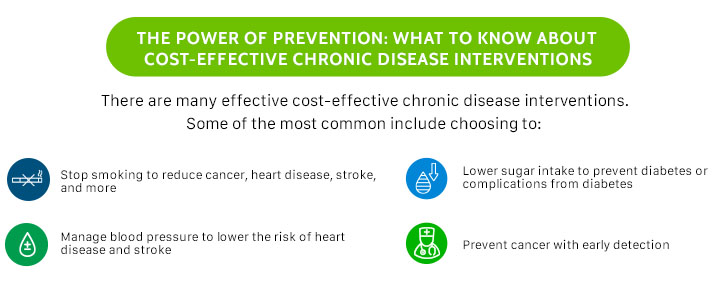
Preventing expensive chronic diseases like diabetes, cancer, and high blood pressure significantly lowers healthcare costs for the industry and for patients.
Chronic diseases continue to be one of the largest healthcare issues in the U.S., leading to negative outcomes from disability to death. These conditions are also very costly for the healthcare system, making up the highest portion of the $3.8 trillion healthcare costs per year with which the country currently contends.
While medical technology and the delivery of care improve each year, we still have a long way to go to reduce these substantial costs. One proven method is to focus on prevention with the right chronic disease interventions to promote healthy communities and individuals. Everyone benefits when we can be proactive – instead of reactive – against chronic diseases. Preventative measures and developing healthy behaviors also mean more positive health outcomes and a lower financial burden on the entire healthcare system.
Here are proven cost-effective chronic disease interventions that extend lives, improve quality of life and are positive steps toward chronic disease prevention.
Stop smoking
Even with the big push over the last few decades to advertise the health risks associated with smoking, Americans continue to have a problem with cigarettes. According to Centers for Disease Control and Prevention (CDC) data:
- Nearly 14 out of every 100 adults in the U.S. over age 18 smoke cigarettes
- More than 16 million Americans live with a smoking-related disease
- Smoking accounts for about one in five deaths — over 480,000 each year
What’s more, the CDC states that tobacco use is the number-one cause of preventable disease, disability, and death in the U.S. That’s because smoking harms the entire body and can is a major risk factor cancer, lung disease, heart disease, stroke, type 2 diabetes, and sudden infant death syndrome.
Smoking is thus very costly on the U.S. health system:
- Annual costs from smoking are over $300 billion.
- That includes more than $225 billion in direct medical costs.
- Premature death related to smoking contributes to over $156 billion every year.
- Tobacco use is attributable to $1.4 trillion a year in global healthcare costs and lost productivity.
The simple choice to stop smoking (or to not smoke) thus makes monumental impacts on healthcare costs and could be the first and most important step towards healthy living. This intervention is completely free for many people and low cost for those who pay for methods to help them quit, making it one of the most important in chronic disease prevention.
Managing blood pressure
Managing and lowering high blood pressure is another of the cost-effective step chronic disease interventions. The healthcare industry sees $79 billion annually in medical costs associated with high blood pressure. It’s estimated that people who have high blood pressure see costs increase up to $2,500 more when compared to people without high blood pressure.
Important interventions that will reduce healthcare costs of hypertension include:
- Increased community public health resources with information about healthy lifestyle changes to lower blood pressure
- More at-home monitoring of blood pressure in conjunction with healthcare provider monitoring
- More team-based care approaches, where people with high blood pressure work together with their physicians, pharmacists, and other healthcare professionals
- More commitments to lifestyle changes like daily exercise, eating healthy foods to help lower cholesterol, and reducing stress levels
Almost one in two Americans has high blood pressure, or hypertension, which can increase risk for cardiovascular disease and stroke. Many people may not know they have high blood pressure because there are usually no symptoms, so it must be measured regularly to know for sure.
Preventing diabetes or complications from diabetes
Diabetes is among the extremely costly chronic diseases in the U.S., and it’s often preventable. It’s estimated that one in three Americans will develop type 2 diabetes at some point during their lifetime, and vital organs are damaged when the disease isn’t managed properly.
- Over 34 million people have diabetes — around one in 10 — and one in three people have prediabetes.
- The total cost of diabetes is $327 billion per year.
- It’s the most expensive chronic condition in the U.S.
- Alarmingly, $1 of every $4 in healthcare costs is spent on caring for people with diabetes.
As with many chronic conditions, preventing type 2 diabetes begins with making healthy choices, like improving diet, engaging in physical activity, lowering stress levels, and developing better habits overall.
Maintaining a healthy weight or taking steps to manage obesity can also be an effective means of diabetes prevention. Indeed, there are many other health benefits associated with managing weight effectively, from reducing the risk of health problems such as hypertension and osteoporosis to improving general wellness and mental health.
In addition, people who have diabetes can help lower their healthcare costs by preventing complications. This can be done by managing blood sugar more effectively to reduce risk for further disease, managing blood pressure, having regular exams, and taking kidney protective medications.
Preventing cancer with early detection
Cancer is the second-leading cause of death in the U.S. behind heart disease. Breast cancer is the most common type for women, and colorectal cancer is the second-most-common type for both men and women.
- Breast cancer contributes $16.5 billion annually in medical costs.
- That equates to 13% of all cancer treatment costs in the U.S.
- Colorectal cancer contributes $14.1 billion.
- That’s 11% of all cancer treatment costs in the U.S.
Early detection is a crucial intervention that can reduce cancer deaths and lower costs on the healthcare system. A good example of possible outcomes is with cervical cancer , which was once the leading cause of cancer deaths for women. This number went down over the last four decades, though, because of the health programs to increase the number of Pap tests that find precancer before it becomes cancer.
Start by lowering your prescription costs
Cost-effective chronic disease interventions like these can help prevent the soaring medical costs associated with care, both for healthcare institutions and their patients. When you’re facing high costs associated with a chronic disease, one way to save is to lower the cost of your prescriptions.
With ModRN Health, you can save up to 80% on prescriptions by learning where you can find the best discounts. You also earn Reward Points by signing up, by getting your prescriptions filled through our service, and when anyone you refer fills their prescriptions, then cash them in later via gift cards. Everything is free and easy for you to use. .
Create an account for free to get started.








